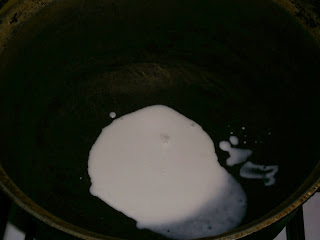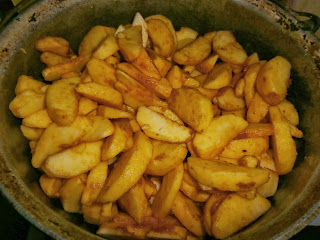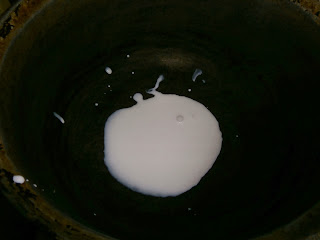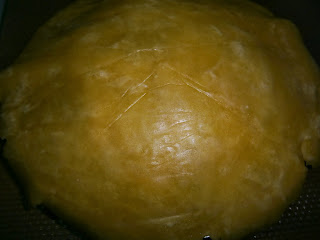Sunt mare
amatoare de plăcinte. Şi cum, după mine, plăcintele în stil american sunt cele mai bune (în afară de cele făcute de bunica mea), iar ieri a fost Ziua Recunoştinţei, am ales să
sărbătoresc cu două plăcinte clasice: de mere şi de dovleac.
Am folosit aceeaşi reţetă de aluat (aluat cu ulei, de la Elisabeth Ho. – în comentarii) pentru ambele plăcinte, dar l-am pregătit separat pentru fiecare şi l-am personalizat puţin pentru o aromă deosebită.
Aluat (pentru o singură plăcintă, pregătită într-o tavă de circa 23 cm diametru): Am folosit aceeaşi reţetă de aluat (aluat cu ulei, de la Elisabeth Ho. – în comentarii) pentru ambele plăcinte, dar l-am pregătit separat pentru fiecare şi l-am personalizat puţin pentru o aromă deosebită.
- 260 g făină
- 1,5 linguriţe sare
- ½ linguriţă mahlab
- 120 ml ulei vegetal
- 5 linguri apă cu gheaţă
Pentru finisat plăcinta:
varianta 1
- 2-3 linguri frişcă lichidă
- 1-2 linguri zahăr tos
varianta 2
- 1 gălbenuş mare
- 1 lingură apă călduţă
varianta 3
- 1 albuş bătut uşor
- 1-2 linguri zahăr tos
Cernem făina şi
sarea într-un castron încăpător, apoi adăugăm o linguriţă de mahlab (pentru o
aromă deosebită).
Formăm două bile
de aluat, le învelim în folie de plastic şi le dăm la frigider pentru 30-60 de
minute.
Între timp,
pregătim umplutura.
PLĂCINTĂ DE MERE
Umplutura de mere:
- 50 ml frişcă
- 100 g zahăr tos
- 100 g zahăr brun
- 1 linguriţă extract de vanilie (sau ½ păstaie de vanilie)
- ½ păstaie tonka rasă
- 1/4 linguriţă scorţişoară
- 1/8 linguriţă nucşoară măcinată
- 2 kg mere (diferite soiuri)
- 2 linguri oţet de mere
- 3 linguriţe amidon
Spălăm, decojim şi curăţăm merele de cotor, apoi le tăiem felii de circa 1-1,5 cm grosime şi le punem deoparte.

Punem la fiert frişca într-o oală încăpătoare, la foc potrivit. Adăugăm zahărul, vanilia, păstaia de tonka rasă, scorţişoara şi nucşoara şi amestecăm.
Adăugăm apoi
merele, amestecăm uşor şi acoperim oala, lăsând merele să se coacă. Amestecăm din
când în când, până ce lichidul începe să fiarbă şi merele au început să să
înmoaie (cam 10 minute).
Între timp,
amestecăm într-un castronel oţetul de mere şi amidonul.
Turnăm amestecul la fundul oalei, făcând o gaură în mere. Amestecăm uşor şi mai lăsăm pe foc circa 5-10 minute – merele ar trebui să fie coapte, dar nu prea moi.
PLĂCINTĂ DE DOVLEACTurnăm amestecul la fundul oalei, făcând o gaură în mere. Amestecăm uşor şi mai lăsăm pe foc circa 5-10 minute – merele ar trebui să fie coapte, dar nu prea moi.
Umplutura de dovleac:
Scoatem din frigider o bilă de aluat şi o întindem între două foi de copt, umezind blatul de lucru pentru a împiedica foaia să alunece. Întindem aluatul dinspre mijloc spre margine (cu mişcări ferme şi cât mai rapid) până obţinem o foaie rotunda de circa 30 cm în diametru. Dacă aluatul se rupe în timp ce îl întindem, putem să îl lăsăm un minut să se încălzească, apoi reluăm.
Pentru a transfera aluatul în tavă, dezlipim foaia de deasupra, apucăm de dedesubt cealaltă foaie şi răsturnăm aluatul în tavă, apoi dezlipim foaia. Aşezăm bine aluatul pe fundul şi marginile tăvii, lăsând un exces de circa 2 cm.
- 50 ml frişcă
- 100 g zahăr tos
- 100 g zahăr brun
- 1 linguriţă extract de vanilie (sau ½ păstaie de vanilie)
- ½ păstaie tonka rasă
- 1/4 linguriţă scorţişoară
- 1/8 linguriţă nucşoară măcinată
- 1/8 linguriţă pudră de ghimbir
- 1/8 linguriţă cuişoare măcinate
- 2 kg dovleac
- 2 linguri oţet de mere
- 3 linguriţe amidon
Tăiem
dovleacul în două, eliminăm sminţele, apoi tăiem jumătăţile în bucăţi mai mari
şi le curăţăm de coajă. Le tăiem apoi în cuburi nici prea mici, nici prea mari
(se vor mai micşora la copt) şi le punem deoparte (eu am folosit nişte dovleac
pe care îl aveam în congelator, pe care l-am decongelat şi tăiat în bucăţi mai
mici).
Punem la
fiert frişca într-o oală încăpătoare, la foc potrivit. Adăugăm zahărul,
vanilia, păstaia de tonka rasă, scorţişoara, nucşoara, pudra de ghimbir şi cuişoarele şi amestecăm.
Adăugăm apoi
dovleacul, amestecăm uşor şi acoperim oala, lăsând dovleacul să se coacă. Amestecăm
din când în când, până ce lichidul începe să fiarbă şi dovleacul a început să
să înmoaie (cam 15-20 minute).
Între timp,
amestecăm într-un castronel oţetul de mere şi amidonul.
Turnăm amestecul la fundul oalei, făcând o gaură în dovleac. Amestecăm uşor şi mai lăsăm pe foc circa 5-10 minute – dovleacul ar trebui să fie copt, dar nu prea moale.
Lăsăm umplutura
să se răcească măcar 30 de minute (dacă e posibil, chiar peste noapte).Turnăm amestecul la fundul oalei, făcând o gaură în dovleac. Amestecăm uşor şi mai lăsăm pe foc circa 5-10 minute – dovleacul ar trebui să fie copt, dar nu prea moale.
FINISAREA
PLĂCINTEI
Scoatem din frigider o bilă de aluat şi o întindem între două foi de copt, umezind blatul de lucru pentru a împiedica foaia să alunece. Întindem aluatul dinspre mijloc spre margine (cu mişcări ferme şi cât mai rapid) până obţinem o foaie rotunda de circa 30 cm în diametru. Dacă aluatul se rupe în timp ce îl întindem, putem să îl lăsăm un minut să se încălzească, apoi reluăm.
Pentru a transfera aluatul în tavă, dezlipim foaia de deasupra, apucăm de dedesubt cealaltă foaie şi răsturnăm aluatul în tavă, apoi dezlipim foaia. Aşezăm bine aluatul pe fundul şi marginile tăvii, lăsând un exces de circa 2 cm.
Întindem la fel şi a doua bilă de aluat într-o foaie rotunda cu aceleaşi dimensiuni.
Punem la frigider atât tava acoperită cu aluat, cât şi a doua foaie, lăsându-o între foile de copt, pentru cel puţin 30 de minute.
Punem o folie de aluminiu pe grătarul cuptorului (în cazul în care curge umplutură din plăcintă) şi preîncălzim la foc iute (220° Celsius).
Punem la frigider atât tava acoperită cu aluat, cât şi a doua foaie, lăsându-o între foile de copt, pentru cel puţin 30 de minute.
Punem o folie de aluminiu pe grătarul cuptorului (în cazul în care curge umplutură din plăcintă) şi preîncălzim la foc iute (220° Celsius).
Scoatem tava
de plăcintă acoperită cu aluat din frigider şi punem peste aluat umplutura rece
(de mere / de dovleac), formând o movilă în centru – nu trebuie pus
tot sucul lăsat de fructe, ci doar câteva linguri.


 |
| Mere |
 |
| Dovleac |
Acoperim umplutura
cu a doua foaie şi tăiem marginile, lăsând cam 2 cm în afară. Împăturim marginile
celor două foi şi presăm uşor ca să închidem bine. Putem lăsa marginea simplă
sau să o decorăm cu ajutorul degetelor sau cu o furculiţă.
Ungem foaia
de deasupra şi marginile plăcintei alegând una din cele 3 opţiuni prezentate
mai sus (opţiunea 1 şi 3: frişca / albuşul pentru uns, zahărul pentru presărat;
opţiunea 2: un amestec de gălbenuş şi apă călduţă pentru uns) – eu am folosit
opţiunea 1.
Facem cu un
cuţit câteva deschizături în centru, astfel încât aburul să poată ieşi în timp
ce plăcinta se coace.
Punem tava
la cuptor, pe foaia de copt şi coacem plăcinta 15 minute la foc iute. Reducem temperatura
şi mai coacem la foc potrivit (180° Celsius) alte 30-40 de minute – crusta trebuie
să fie aurie şi umplutura să bolborosească. Dacă marginile plăcintei tind să se
ardă, le putem acoperi cu folie de aluminiu, lăsând plăcinta să se coacă în
continuare până este gata.
Transferăm tava
cu plăcinta pe un grătar şi o lăsăm să se răcească 3-4 ore sau peste noapte. Astfel,
fructele vor reabsorbi o parte din sucuri.
 |
| Mere |
 |
| Dovleac |
Porţionăm apoi
plăcinta şi o servim (simplă, pudrată cu zahăr amestecat cu scorţişoară, cu
îngheţată etc.).
Poftă bună!
Poftă bună!
Urmând
tradiţia americană, am să vă împărtăşesc motivele pentru care sunt eu
recunoscătoare: pentru aventura minunată pe care am început-o în vară cu at e., pentru voi care îmi sunteţi
alături la fiecare postare, pentru vacanţele frumoase pe care le-am avut anul
acesta (sper că şi cea care urmează va fi la fel), pentru prietenii care au
fost alături de mine când am avut nevoie, pentru reuşitele profesionale (printre
care lucrarea mea de disertaţie, la care am muncit cu multă pasiune), pentru
concertul uimitor la care am fost prezentă (Josh Groban, în iunie, la Paris),
pentru familia mea, care mă susţine chiar şi atunci când nu este de acord cu
mine, pentru prietenii mei (cu două sau patru picioare) de la NanaFarm şi – ultimul
pe listă, dar primul ca importanţă – pentru EL. Mulţumesc!
Happy
Thanksgiving Day!
******************************************************************************************************
I absolutely love pies. So, because I believe that American style pies are the best (after those made by my grandmother) and also because yesterday was Thanksgiving Day, I chose to celebrate with two classic pies: apple and pumpkin pies.
I used the same recipe for the pastry (oil pastry, from Elisabeth Ho. – see the comments) for both pies, but I made it twice and added a personal touch for a special flavor. As for my pumpkin filling, because I wanted to make a double-crust pie instead of the classic American pumpkin pie (creamy filling and no top crust), I followed the recipe for the apple pie (also modified a little), making some small changes to be fit with the pumpkin.
I’ll just tell one
more thing and show you the recipes: you can find some valuable advice for excellent
pies here, here, here, here and here.
THANKSGIVING PIES
Pastry (for one pie, baked in a 23 cm pan):
- 260 g all purpose flour
- 1.5 teaspoons salt
- ½ teaspoon mahlab
- 120 ml vegetable oil
- 5 tablespoons ice water
For brushing and sprinkling the pie:
option 1
option 1
- 2-3 tablespoons cream
- 1-2 tablespoons granulated sugar
- 1 large yolk
- 1 tablespoon warm water
- 1 white, lightly whisked
- 1-2 tablespoons granulated sugar
We sift together in a large bowl the flour and salt and then add in one teaspoon of mahlab (for a special flavor).
We pour in a cup the oil and water and, without stirring, pour all at once into the flour mixture.
We stir lightly with a fork until combined.
We form two balls of pastry, wrap them in plastic and refrigerate them for 30 to 60 minutes.
We pour in a cup the oil and water and, without stirring, pour all at once into the flour mixture.
We stir lightly with a fork until combined.
We form two balls of pastry, wrap them in plastic and refrigerate them for 30 to 60 minutes.
APPLE PIE
Apple filling:
- 50 ml cream
- 100 g granulated sugar
- 100 g brown sugar
- 1 teaspoon vanilla extract (or ½ vanilla bean)
- ½ tonka bean (ground)
- 1/4 teaspoon ground cinnamon
- 1/8 teaspoon freshly ground nutmeg
- 2 kg apples (various types)
- 2 tablespoons apple cider vinegar
- 3 teaspoons cornstarch
We wash, peel and core the apples, then cut them into 1-1.5 cm slices and set aside.
We boil the cream in
a pot over medium heat. We add in the sugar, vanilla, ground tonka bean, cinnamon
and nutmeg and stir until combined.
We then gently fold in
the apple slices, cover the pot and let the apples cook, stirring occasionally,
until the liquid is boiling and the apples started to soften (about 10
minutes).
Meanwhile, we whisk
together the cider vinegar and cornstarch in a small bowl. We pour
the mixture into the bottom of the pot, making a well in the apples. We gently
toss to combine and let the apples cook for another 5-10 minutes – they should
be tender, but not too soft.
We leave the filling
to cool at least 30 minutes (if possible overnight).
PUMPKIN PIE
Pumpkin filling:
We cut the pumpkin in half, scrape out the seeds, then cut the halves in large pieces and peel them. We then cut them into cubes (not too small, as they will shrink when cooked) and set aside (I used some pumpkin I had in the freezer, which I thawed and just cut into smaller pieces).
FINISHING THE PIE
We remove one ball of pastry from the fridge and roll it between two parchment sheets, dampening the countertop so that it won't slip. We work the pastry from the middle outwards (with firm strokes and as little as possible) until we obtain a circle about 30 cm in diameter. If the pastry cracks when rolling, we let it stand for one minute to warm up, then try again.
- 50 ml cream
- 100 g granulated sugar
- 100 g brown sugar
- 1 teaspoon vanilla extract (or ½ vanilla bean)
- ½ tonka bean (ground)
- 1/4 teaspoon ground cinnamon
- 1/8 teaspoon freshly ground nutmeg
- 1/8 teaspoon ground ginger
- 1/8 teaspoon ground cloves
- 2 kg butternut pumpkin
- 2 tablespoon apple cider vinegar
- 3 teaspoon cornstarch
We cut the pumpkin in half, scrape out the seeds, then cut the halves in large pieces and peel them. We then cut them into cubes (not too small, as they will shrink when cooked) and set aside (I used some pumpkin I had in the freezer, which I thawed and just cut into smaller pieces).
We boil the cream in a pot over medium heat. We add in the sugar, vanilla, ground tonka bean, cinnamon, nutmeg, ginger and cloves and stir until combined.
We then gently fold in the pumpkin cubes, cover the pot and let the pumpkin cook, stirring occasionally, until the liquid is boiling and the pumpkin started to soften (about 15 minutes).
Meanwhile, we whisk together the cider vinegar and cornstarch in a small bowl. We pour the mixture into the bottom of the pot, making a well in the pumpkin. We gently toss to combine and let the pumpkin cook for another 5-10 minutes – it should be tender, but not too soft.
We leave the filling to cool at least 30 minutes (if possible overnight).We remove one ball of pastry from the fridge and roll it between two parchment sheets, dampening the countertop so that it won't slip. We work the pastry from the middle outwards (with firm strokes and as little as possible) until we obtain a circle about 30 cm in diameter. If the pastry cracks when rolling, we let it stand for one minute to warm up, then try again.
To transfer the crust to the pie pan, we remove the top parchment sheet, slide our hands under the bottom parchment sheet and flip it into the pan, then peel off the paper. We ease the crust into the bottom and sides of the pan and leave an excess edge of 2 cm.
We roll the second ball of pastry into a circle roughly 30 cm in diameter, following the same instructions. We refrigerate it between the parchment sheets together with the bottom crust for at least 30 minutes.
We place a aluminum foil on the center rack in the oven (to catch any drips from the pie) and preheat
to 220° Celsius.
We remove the pie pan
with the bottom crust from the fridge and transfer the cooled filling (apples /
pumpkin) to the pie, in a tall mound in the center – we mustn’t use all the
juice left from the fruits, a few tablespoons will do.
We put the top crust
over the pie and trim the edges, leaving about 2 cm in excess. We fold the edge
of the top crust over the bottom crust and press them lightly to seal. We can
leave the folded edge simple or use our fingers or a fork to decorate it.
We brush the top crust
and the edge using one of the 3 options presented above (option 1 and 3: cream
/ white for brushing, sugar for sprinkling; option 2: mixture of yolk and warm
water for brushing) – I used option 1.
We then cut several
vents in the center to allow the steam to escape during baking time.
We place the pie on
the preheated parchment paper and bake for 15 minutes at 220° Celsius. We reduce the heat to 180° Celsius and bake the pie for another 30-40
minutes – the crust must be golden brown and the fruit filling bubbling. If the
edges of the crust darken too quickly, we can cover them with aluminum foil and
continue baking.
We transfer the pie
pan on a wire rack and let the pie cool for 3-4 hours or overnight. This will
let the fruit reabsorb some of the juices.
We can then slice the
pie and serve (simple, powdered with sugar-cinnamon, with ice-cream etc.).
Enjoy!
Following the American tradition, I will share with you the reasons for which I am grateful: for the wonderful adventure I began this summer with at e., for all of you who follow my blog, for my friends who were there for me when I needed most, for my professional successes (among which my dissertation paper, done with so much passion), for the amazing concert I witnessed (Josh Groban, June, Paris), for my family, who supports me even when we have different opinions, for my friends (with two or four legs) from NanaFarm and – last, but not least – for HIM. Thank you!
Happy Thanksgiving Day!



















































Niciun comentariu:
Trimiteți un comentariu